Walk into any classroom, and you’ll immediately feel the difference that good lighting makes.
As an educator who’s spent years optimizing learning environments, I’ve seen firsthand how the right lighting can transform student engagement, reduce eye strain, and create an atmosphere where both teaching and learning thrive.
Poor lighting doesn’t just strain eyes-it affects concentration, mood, and even behavior. Students squint at worksheets under harsh fluorescents or struggle to stay alert in dimly lit corners.
Meanwhile, teachers juggle the challenge of creating inviting spaces while managing tight budgets and energy costs.
That’s why I’m excited to share these 11 practical lighting ideas that have worked wonders in real classrooms.
From simple DIY solutions to smart energy-efficient upgrades, these strategies will help you create a brighter, more inspiring space where your students can truly shine. Let’s light up learning together!
Why Classroom Lighting is Important

After observing thousands of students, I’ve seen how proper lighting dramatically improves focus and academic performance.
When students can see clearly without straining, they concentrate better and maintain attention throughout lessons, while adequate lighting reduces fatigue and restlessness.
Lighting also affects mood and emotional well-being in educational settings.
Warm, inviting light creates psychological comfort that helps students feel relaxed and open to learning, while harsh lighting increases stress and creates unwelcoming environments.
Natural light particularly reduces anxiety and improves classroom atmosphere.
Smart lighting choices benefit both learning outcomes and school budgets. LED fixtures and energy-efficient systems can reduce costs by up to 75% compared to traditional methods, freeing funds for other resources while requiring less maintenance and creating long-term value.
List of 11 Inspiring Classroom Lighting Ideas
Creative lighting solutions that improve student focus, create welcoming atmospheres, and transform ordinary classrooms into engaging learning environments.
1. Natural Light Integration
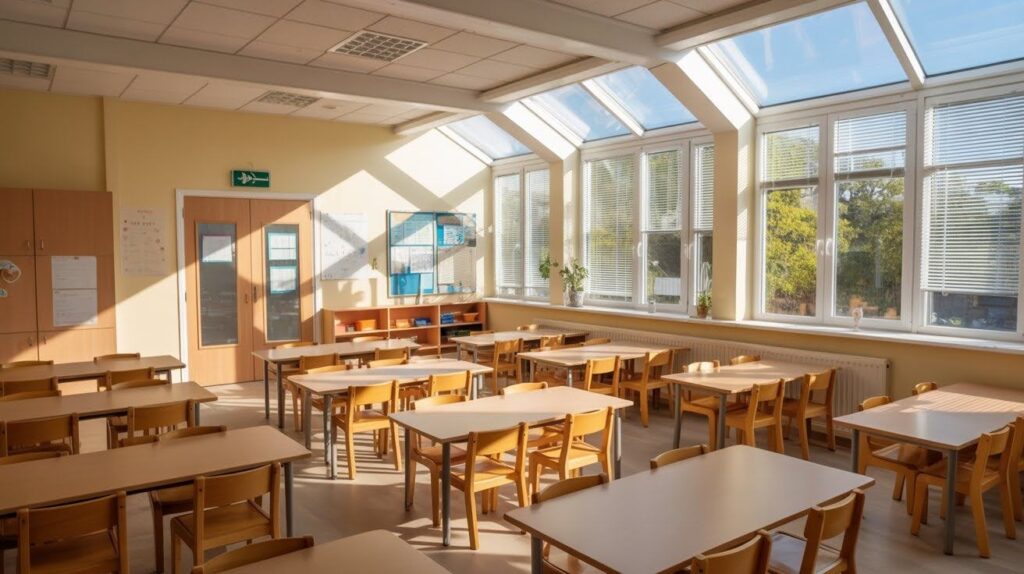
Nothing beats the power of sunlight for creating an energizing learning environment. I always recommend maximizing windows by keeping them unobstructed and using light-colored blinds that can be adjusted throughout the day.
Skylights and glass panels near doorways bring additional natural light into interior spaces, reducing the need for artificial lighting during daytime hours.
The key is balancing brightness to avoid glare on whiteboards or computer screens while still flooding your classroom with that beautiful, mood-boosting natural illumination.
2. Adjustable LED Lighting
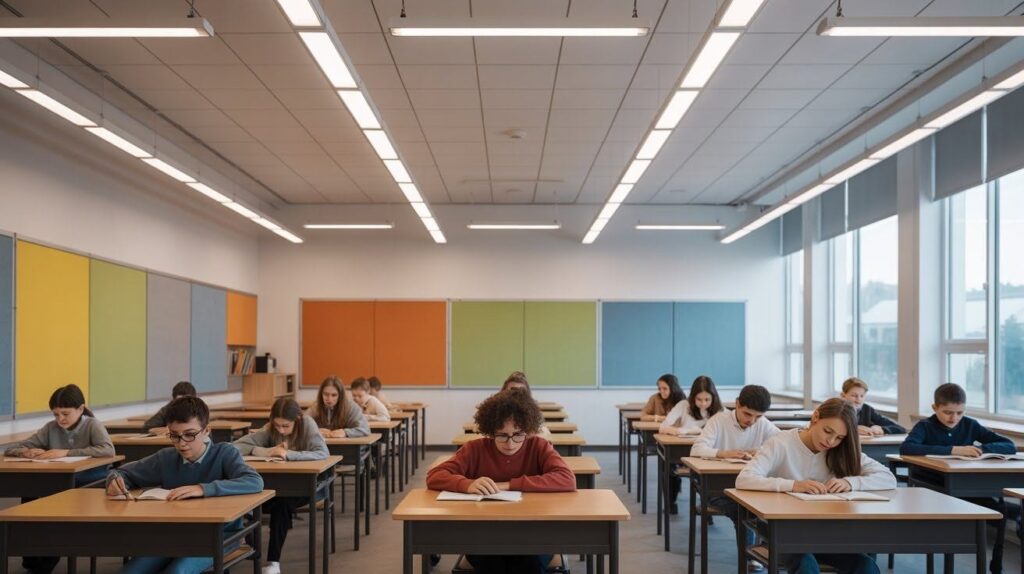
Flexibility is everything when it comes to classroom lighting, and adjustable LED systems give you complete control over your learning environment.
During focused reading time, you can increase brightness to help students concentrate, then dim the lights for movie presentations or relaxation periods.
I love how these systems allow teachers to adapt lighting instantly based on different activities throughout the day.
The energy savings are impressive, too-most schools see significant reductions in their electricity bills after switching to adjustable LED setups.
3. Task Lighting for Desks and Reading Corners
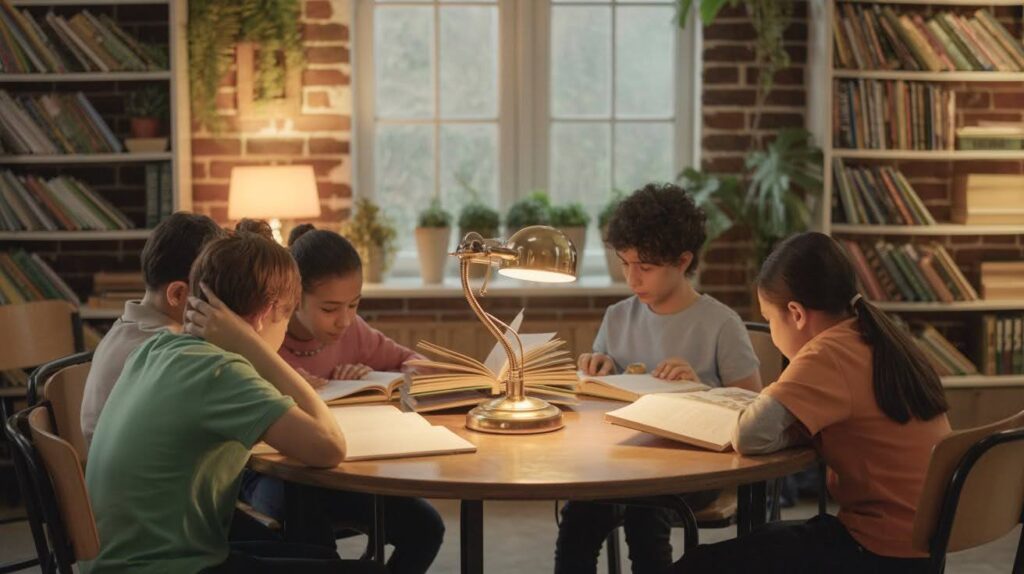
Individual task lighting transforms how students interact with their work, especially in reading corners or during detailed projects.
Small desk lamps or clip-on lights give students control over their workspace illumination, reducing eye strain during close-up tasks.
I’ve found that students with their lighting sources tend to stay more engaged and comfortable during independent work time.
Battery-operated or USB-powered options work particularly well since they don’t require additional electrical outlets or create cord management issues.
4. Warm Ambient Lighting for a Cozy Feel

Creating a homelike atmosphere through warm ambient lighting works wonders, especially with younger students who may feel anxious in institutional settings.
Table lamps with soft, warm bulbs placed strategically around the room create pockets of comfort that make the space feel more inviting.
Floor lamps in reading areas or corner spaces add that cozy touch that helps students relax and feel more comfortable participating in class discussions.
The warm light temperature (around 2700K) mimics evening home lighting that children associate with safety and comfort.
5. Color-Changing Smart Lights

Smart lighting systems that change colors add an element of engagement and functionality that students love.
Blue light during morning lessons can help with alertness and focus, while warmer tones during afternoon activities promote calm concentration.
I’ve seen teachers use color changes to signal transitions between activities or create themed lighting for special subjects like science experiments or creative writing.
These systems often come with smartphone apps that make it easy to customize lighting throughout the day.
6. Pendant Lights for Modern Classroom Design

Pendant lights bring both style and focused illumination to classroom spaces, particularly over collaborative work areas or teacher stations.
They provide excellent task lighting while adding visual interest to the ceiling plane, making classrooms feel more modern and professionally designed.
I recommend choosing adjustable-height pendants so you can modify the lighting based on different furniture arrangements or activities.
The downward light distribution works perfectly for group tables or demonstration areas where you need concentrated brightness.
7. Under-Cabinet or Shelf Lighting
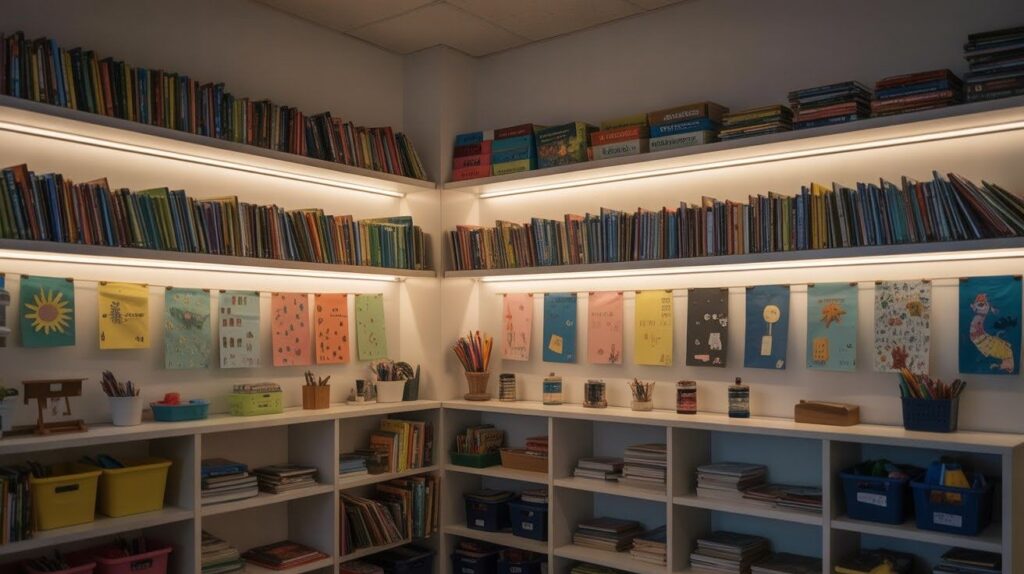
Strategic lighting under cabinets and shelves serves multiple purposes-highlighting student displays, illuminating storage areas, and adding layers of ambient light throughout the room.
LED strip lights are perfect for this application since they’re energy-efficient, easy to install, and create even illumination along entire shelf lengths.
This type of lighting makes it easier for students to find materials and adds visual depth to classroom walls. Battery-operated strips work well in areas without convenient electrical access.
8. Soft Lighting for Relaxation Zones

Every classroom benefits from a designated quiet space with gentle, calming lighting that helps students decompress or focus on independent reading.
Salt lamps, fabric-covered table lamps, or soft LED strips create peaceful environments where overstimulated students can regain their composure.
I’ve found that these relaxation zones become popular spots during free reading time or when students need a moment to process information quietly. The key is choosing lighting that feels noticeably different from the main classroom illumination.
9. Interactive Projector Lighting
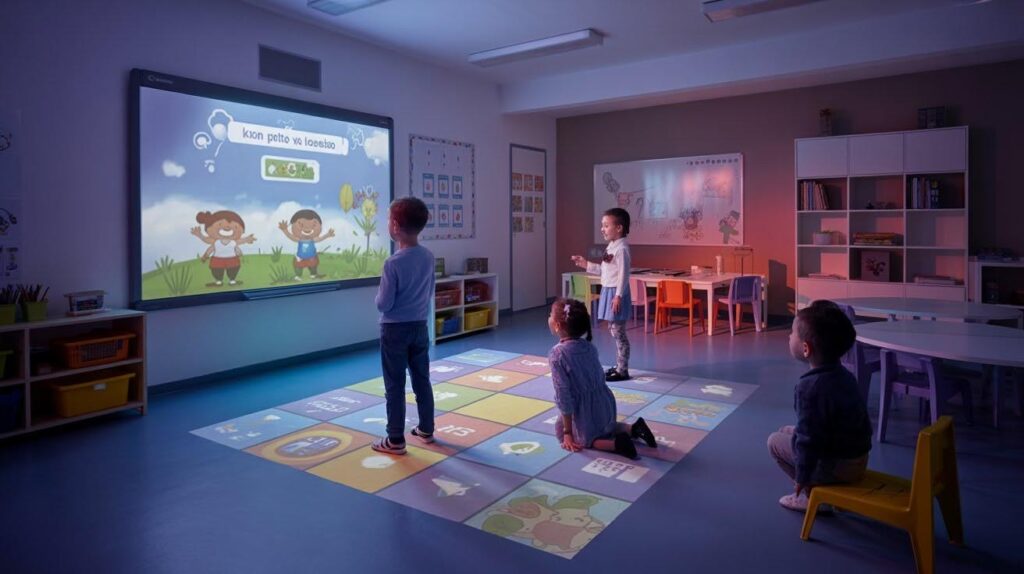
Modern projector systems that combine display technology with interactive lighting create dynamic learning experiences that captivate student attention.
These systems can project educational content while providing ambient lighting that changes based on lesson content or student responses.
Interactive floor projectors are particularly engaging for younger students, turning the entire classroom floor into a learning surface. The combination of visual learning and responsive lighting helps accommodate different learning styles while keeping students actively engaged.
10. Eco-Friendly Solar Lighting Options
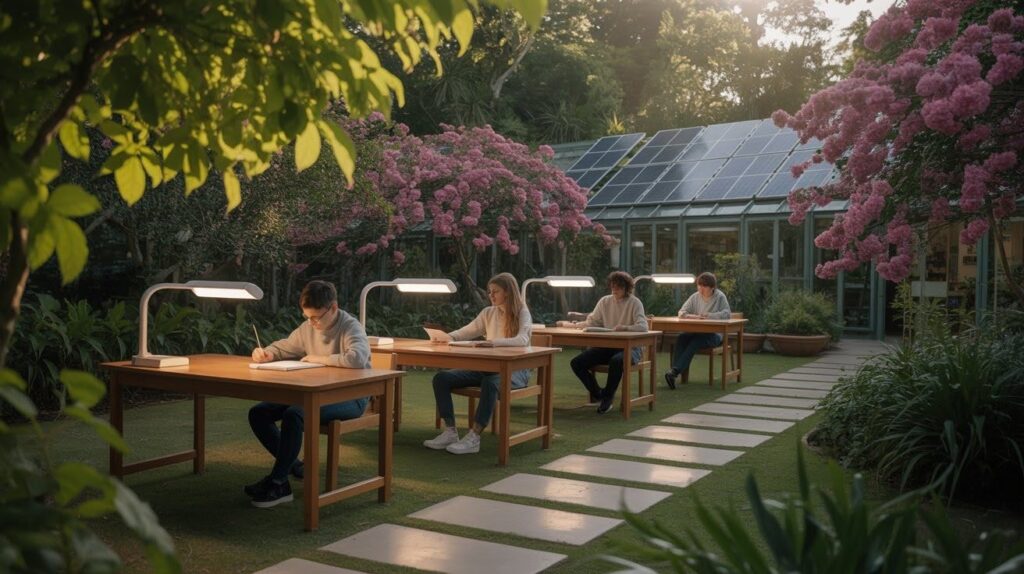
Solar-powered lighting solutions offer sustainable options for schools committed to environmental responsibility while reducing energy costs.
Solar desk lamps, pathway lights for outdoor classroom spaces, and solar-charged LED systems work particularly well in areas with good natural light exposure.
These options teach students about renewable energy while providing practical illumination for learning activities. Many solar lights include USB charging capabilities, making them versatile for various classroom applications.
11. Decorative String or Fairy Lights for Creativity
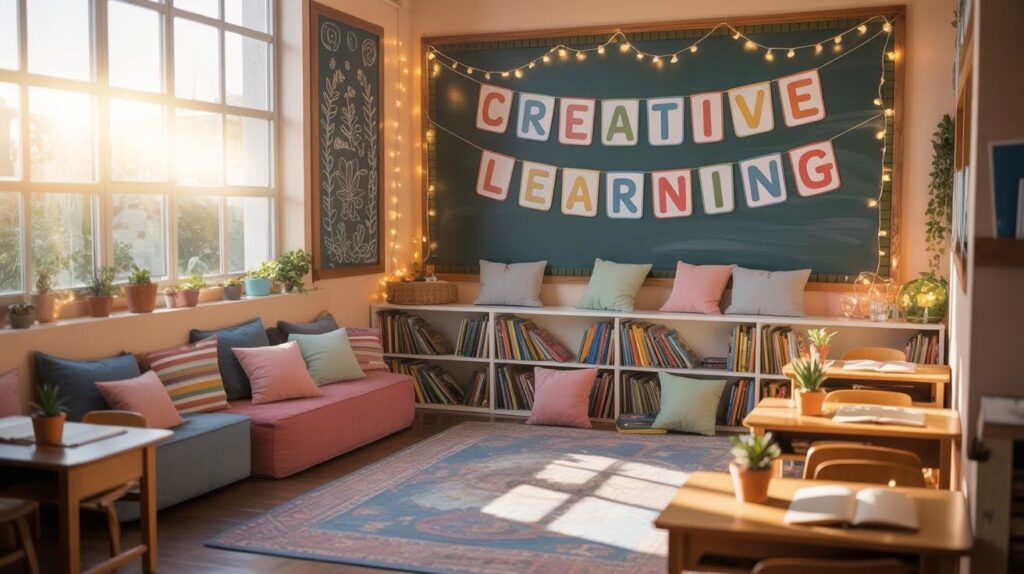
String lights add magical ambiance that sparks creativity and makes learning spaces feel special and inspiring.
Battery-operated fairy lights can outline bulletin boards, frame reading corners, or create cozy study nooks without requiring electrical modifications.
I love how these lights instantly transform ordinary classroom spaces into environments that feel more like creative studios or comfortable learning lounges.
Choose warm white LED strings for energy efficiency and safety, and involve students in planning where to place them for maximum impact.
Tips for Choosing the Best Classroom Lighting
- Elementary students benefit from warmer, softer lighting that creates comfortable environments, while older students need focused, task-oriented lighting with cooler temperatures for detailed work.
- Art classes require excellent color-rendering light, while science labs need bright, shadow-free illumination for safe experiments and observations.
- Maximize natural light through strategic window treatments and reflective surfaces, but maintain consistent artificial backup for weather changes.
- Layer different lighting types-overhead fixtures for general illumination, task lights for detailed work, and accent lighting for visual interest.
- Install dimmable systems to adjust artificial lighting based on available natural light, ensuring consistent brightness throughout the day.
- LED fixtures use up to 80% less energy than traditional bulbs while lasting significantly longer, reducing maintenance disruptions.
- Look for ENERGY STAR ratings and smart controls like motion sensors that automatically adjust based on classroom occupancy.
- Many utility companies offer rebates for schools upgrading to efficient lighting systems, making transitions more budget-friendly.
Final Thoughts
After years of transforming classrooms, I have one question: which of these 11 lighting ideas made you stop and think, “That’s exactly what my classroom needs”? The cozy string lights or those game-changing adjustable LEDs?
I’ve watched proper lighting reduce teacher fatigue while boosting student engagement. The results speak for themselves-more participation, less eye strain, and inviting atmospheres where learning thrives.
Here’s my challenge: don’t wait for perfect timing or full budget approval. Pick one idea that excites you and try it next week.
Maybe it’s a simple desk lamp in your reading corner or warm lights around your bulletin board. Start small, watch your students’ reactions, and let their enthusiasm guide your next upgrade. What will you try first?
Frequently Asked Questions
What type of lighting works best for different age groups?
Elementary students thrive with warmer, softer lighting that creates comfortable, home-like environments where they feel secure. Middle and high school students need brighter, more focused lighting that supports detailed work and maintains alertness during longer class periods.
How can I balance natural and artificial lighting in my classroom?
Maximize natural light through strategic window treatments and reflective surfaces, but maintain consistent artificial backup for cloudy days. Layer different artificial light sources-overhead fixtures, task lights, and accent lighting, that can be dimmed based on available sunlight.
Are LED lights worth the investment for schools?
LED fixtures use up to 80% less energy than traditional bulbs and last significantly longer, reducing both electricity costs and maintenance disruptions. Most schools see the initial investment pay for itself within the first year through reduced utility bills and replacement costs.
What lighting options work best for reading corners and quiet spaces?
Soft table lamps, floor lamps with warm bulbs, or battery-operated fairy lights create cozy atmospheres perfect for independent reading. Choose lighting with warm color temperatures (around 2700K) that feels comfortable and reduces eye strain during close-up activities.
Can I improve classroom lighting on a tight budget?
Start with simple additions like desk lamps for reading areas or battery-operated LED strips under shelves and cabinets. String lights and small task lights provide immediate improvements without requiring electrical modifications or major budget allocations.

